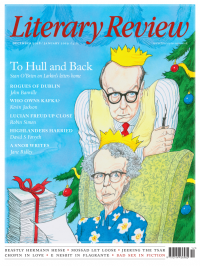Dominic Green
The French Erection
Sentinel: The Unlikely Origins of the Statue of Liberty
By Francesca Lidia Viano
Harvard University Press 577pp £27.95
Like so many immigrants arriving in the United States before me, I first saw the Statue of Liberty at dawn from the deck of a ship. I was in an outdoor Jacuzzi on the deck of the QE2 at the time. In the days since we cast off from the Old World, the only vertical objects in our field of vision had been the waves created by a force eight gale. Then Lady Liberty rose from the flat ocean, wreathed in weird green mist. I couldn’t help but shiver in historical apprehension.
Francesca Lidia Viano’s extravagant and gripping Sentinel tells the statue’s story. Two hundred tons in weight and ninety-three metres tall, made of iron and sheathed in copper, the statue is formally named Liberty Enlightening the World. It was created in Paris, the brainchild of Frédéric-Auguste Bartholdi, a painter and sculptor, and Edouard René Lefèbvre de Laboulaye, the scion of a family of Norman merchants and bureaucrats. According to Bartholdi, the statue was dreamed up by Laboulaye in 1865. In that year he told Bartholdi and a group of friends that France’s sacrifices in the cause of the American Revolution merited ‘a monument … built in America as a memorial to their independence … a common work of both nations’. Twenty-one years later, in 1886, the Statue of Liberty was unveiled in New York.
The account that Bartholdi gave of the statue’s conception at the time of Liberty’s inauguration, Viano writes, omitted a lot of ‘pertinent facts’ about Bartholdi and Laboulaye’s occult motivations and long-standing collaboration. Laboulaye, who had died in 1883, was not around to correct it, and would not have

Sign Up to our newsletter
Receive free articles, highlights from the archive, news, details of prizes, and much more.@Lit_Review
Follow Literary Review on Twitter
Twitter Feed
Alfred, Lord Tennyson is practically a byword for old-fashioned Victorian grandeur, rarely pictured without a cravat and a serious beard.
Seamus Perry tries to picture him as a younger man.
Seamus Perry - Before the Beard
Seamus Perry: Before the Beard - The Boundless Deep: Young Tennyson, Science, and the Crisis of Belief by Richard Holmes
literaryreview.co.uk
Novelist Muriel Spark had a tongue that could produce both sugar and poison. It’s no surprise, then, that her letters make for a brilliant read.
@claire_harman considers some of the most entertaining.
Claire Harman - Fighting Words
Claire Harman: Fighting Words - The Letters of Muriel Spark, Volume 1: 1944-1963 by Dan Gunn
literaryreview.co.uk
Of all the articles I’ve published in recent years, this is *by far* my favourite.
✍️ On childhood, memory, and the sea - for @Lit_Review :
https://literaryreview.co.uk/flotsam-and-jetsam